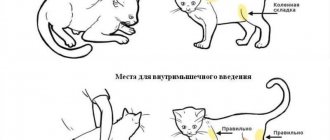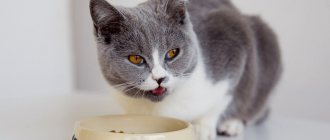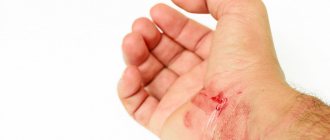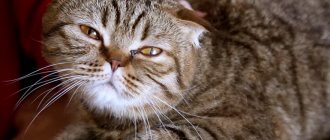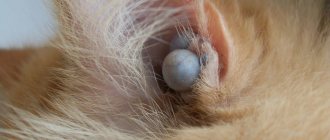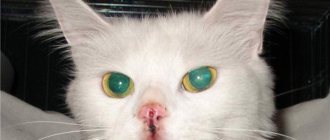If a cat's blood sugar is high, this may be a symptom of hormonal disorders, diseases of the pancreas and liver, or diabetes. High glucose levels are also observed in stressful situations. The owner should know the level of sugar in the animal’s serum and urine and how to monitor the indicators. To normalize the level of the substance, the owner should consult a veterinarian who will prescribe medications and diet.
According to veterinarian Yu. Baburova, in 70% of cases, cats are diagnosed with insulin-dependent diabetes mellitus.
Reasons: why does sugar rise?
The main factors for changes in glucose levels are as follows:
- Endocrine disorders. In cats, acromegaly, hyperthyroidism, and Cushing's syndrome are diagnosed and occur due to dysfunction of the thyroid gland. It is also caused by high production of the hormone cortisol by the adrenal glands. Hormonal imbalance is provoked by poor nutrition (especially feeding chicken necks), iodine deficiency, and tumors of the adrenal cortex.
- Diseases of the liver and pancreas. Such ailments include cholangitis, hepatitis of any etiology, lipidosis, pancreatitis. Pathologies are provoked by poor nutrition, infection with parasites, high levels of calcium in the blood, and uncontrolled use of antibiotics and hormonal drugs by the cat owner.
- Diabetes. A complex of systemic disorders occurs in which the body does not produce insulin. Beneficial substances do not enter organ tissues due to a lack of energy, which occurs only when glucose and insulin interact. The main reason is chronic inflammation of the pancreas.
- Stress. If the animal is nervous, a temporary hormonal imbalance occurs, which leads to an increase in glucose. Stressful situations include moving to a new place, the appearance of a newborn child or another animal in the house, and frequent noisy parties thrown by the owner.
How to prevent diabetes in animals?
Diabetes mellitus in cats cannot always be prevented, but the risk of the disease can be reduced. To do this, you need to follow a few simple recommendations.
A healthy diet is the key to the health and long life of your predator. Wild cats do not suffer from diabetes because they eat fresh meat and the internal organs of their victims. Their diet contains no carbohydrates or artificial ingredients. Harmful substances do not accumulate in the body, food is well absorbed, so they do not suffer from the same ailments that pets suffer from. Natural, biologically appropriate nutrition will help reduce the risk of diabetes.
Play and a cat-friendly environment can help provide physical activity Play with your pet regularly. Leave toys she can play with while she's home alone. Equip your home with a cat tree so your pet can climb and jump. If possible and if she shows interest in the street, take her for a walk on a harness.
Regular checkups with a veterinarian will help detect not only diabetes, but also other health problems, if any. Once a year, have your pet's blood tested to make sure all organs are working as they should.
A healthy diet and an active lifestyle are key to your cat's health.
Norm and tests: how to control glucose?
If your pet’s level is above 6 mmol/l, then this is a sure sign of hyperglycemia.
The normal proportion of blood sugar in a cat is 3-6.1 mmol/l. Low levels (hypoglycemia) are considered to be below 3 mmol/L. Increased glucose (hyperglycemia) - over 6 mmol/l. The normal level of sugar in urine is 0. Even a slight increase in glucose in urine is a reason to have the animal examined. To do this, a fasting blood test is taken (a small amount of plain water is allowed). However, going to the veterinary clinic is very stressful for a cat, so the indicators may be overestimated.
If diabetes is suspected, the veterinarian recommends that the owner independently measure the pet's glucose daily. Urine test strips (Uriglyuk, Glucofan) or a regular medical glucometer (Accu-Chek Active) are suitable for this. It is better to take blood from the vessels at the end of the animal’s ear, after shaving the hair on the ear. Algorithm of actions:
- Turn on the device and insert the test strip into it.
- Match the code on the packaging and on the device monitor.
- Wait until the drop sign appears.
- Puncture the vessel with a glucometer needle.
- Apply the test strip to the drop of blood so that the liquid is absorbed.
- Place a strip of blood in the device and wait for the readings to appear.
- Treat the injection site with an alcohol solution.
To accurately indicate to the veterinarian the dynamics of increased glucose levels, the owner can keep a special journal where the date, time of the analysis and the indicator are recorded.
How to deal with diabetes in your pet?
Insulin. Cats with diabetes need regular insulin injections. They are prescribed by a veterinarian, who will also show you how to make them at home. Injecting is not difficult, you just need to get used to it.
Species-typical nutrition. A natural, species-typical diet helps lower blood sugar levels. Moreover, on a healthy diet, sugar levels may well return to normal and not rise again.
The species-typical diet contains a large amount of animal protein, a moderate amount of fat and only 2-3% carbohydrates. SUPERPET consists of 90% fresh meat and contains only 1% carbohydrates. At the same time, the composition includes all the necessary vitamins and minerals, including taurine. If your pet suffers from diabetes, SUPERPET will help fight the disease.
On a healthy diet, the cat’s body will no longer receive too much sugar, and its metabolism will normalize. In addition, eating healthy will help you lose weight and keep it off.
Physical activity will help keep your pet's weight under control. Play active games with your pet regularly. At first, the cat may be reluctant to play and not for long. If you change your diet to a healthy one, soon the reluctance to play will go away: she will have more energy and will begin to play with pleasure.
Controlling your blood sugar levels is an important part of managing diabetes, especially when starting out. You need to regularly check your sugar levels to understand how they are changing and what dose of insulin to give. In addition, monitoring the cat’s thirst level and urination will help you understand whether sugar is returning to normal. When sugar decreases, thirst decreases, and accordingly, the cat goes to the litter box less often.
One complication that occurs if diabetes in cats is left untreated is ketoacidosis. When the body does not receive energy from glucose, it begins to break down fats to obtain energy from them. During the breakdown of fats, ketones are formed, which accumulate in the body. Ketoacidosis occurs when blood sugar remains elevated for a long time. It can be life-threatening. Signs of ketoacidosis: inactivity, vomiting, refusal to eat, the cat tries to hide in a secluded place.
What to do to normalize sugar?
Drug treatment
If prescribed by a veterinarian, the animal can take Metformin.
All medications are prescribed by a veterinarian; self-medication leads to the death of the animal. To keep blood glucose levels normal, drugs that lower sugar levels are used. These include Glipizide, Miglitol, Gliquidone, Metformin. For insulin-dependent diabetes, insulin injections are prescribed. If hyperglycemia is caused by endocrine diseases, hormonal treatment is used, which the veterinarian prescribes individually. For the medications to work well, any stressful situations in your pet’s life should be eliminated. In case of hypoglycemia, you should give the animal a little honey or sugar solution to increase the level of glucose in the blood, and immediately contact the veterinary clinic, since the condition threatens the cat’s life. In addition, concomitant diseases that cause increased sugar should be treated.
Insulin and Hypoglycemia
Dose and type of insulin for a cat with diabetes.
Only a doctor should select the dose and type of insulin! Insulins are “human” (Levemir, Lantus, etc.) and veterinary (Caninsulin). They also differ in the duration of action - there are short and long. For cats, long-acting insulins are usually used.
What insulin syringes are needed for cats?
He also usually advises which insulin syringes you need to purchase in order to dose insulin correctly, because an overdose of insulin is very dangerous - hypoglycemia can occur, turning into a hypoglycemic coma, with a fatal outcome. There are special syringes for different types of insulin. They come in different gradations and volumes (100 U/ml, 40 U/ml, 50 U/0.5 ml, etc.)
The danger of insulin overdose in diabetes
Remember! It is much worse to overdose on insulin than to underdose! The effects of high glucose develop slowly, but low glucose can lead to death within a few hours! If you are not sure that you have injected the entire dose (for example, the animal twitched at this moment and some of the insulin spilled), never re-inject insulin.
Signs of insulin overdose
Signs of an insulin overdose are as follows: the animal develops weakness, unsteady gait, trembling, loss of consciousness, convulsions, and involuntary urination.
If the animal is still conscious, you should immediately offer it food. If the condition is already severe, or loss of consciousness has occurred, spread something sweet on the mucous membranes of the mouth, tongue, gums - honey, condensed milk, sugar syrup or glucose solution and immediately contact a doctor. Don't wait until the clinic! Take action immediately! In such cases, you may simply not live to see a doctor!
How to give insulin injections to a cat?
Injections should be done strictly in a specific place and not change it without a special reason. The fact is that the rate of absorption in different parts of the body is different, so initially determine with your doctor the most convenient area for administration.
Glucose levels in cats
The normal glucose level in cats is up to 6-8 mmol. In diabetics, it can fluctuate from 6-8 mmol/l to 16-18 mmol/l. If glucose stays in this range, this is good; with such numbers, clinical signs are weak or almost not expressed, and the consequences and complications of this disease are minimal. If the animal visually feels unwell, you should consult a doctor for an examination and adjustment of the insulin dose.
Diabetic cat diet
Diet is of great importance. Usually, special medicinal food is prescribed for diabetics; they are found in almost every line of premium food. You'll have to forget about treats and begging from the table. Only medicated food and water! Normally, after eating, glucose is very high, and a diabetic needs the slowest possible flow of glucose from food into the blood. In medicinal feeds, this is provided by special sources of dietary fiber. In addition, the food must contain a limited amount of calories and a sufficient amount of protein.
Feeding is carried out twice a day. This is necessary to avoid administering glucose on an empty stomach. Insulin injections are always given strictly after feeding, usually within an hour. This is a very important point, because if the animal has not eaten, or has eaten little, or has vomited after eating, the insulin dose must be reduced to avoid hypoglycemia. Switching to two feedings a day will often cause outrage among cats who are accustomed to food always being freely available, but this rule will help to avoid many dangerous moments associated with hypoglycemia.
Can diabetes in cats be cured?
Diabetes in cats
it is curable, but it depends on how quickly the owner consulted a doctor. The earlier treatment is started, the higher the chance. The dose of insulin is gradually reduced, and if glucose remains within acceptable limits and the animal feels well, then within 3-6 months. Insulin may be discontinued. If the need for insulin does not decrease after six months of use, then the chances of recovery are low and most likely, insulin will have to be injected for life.
As a preventative measure, we recommend monitoring your pet's weight. Contrary to popular belief, a cat's thickness is not a sign of its health! Maintaining a normal weight is the simplest method of preventing diabetes.
Health to you and your pets!
Veterinarian: Golneva Tatyana Nikolaevna.
